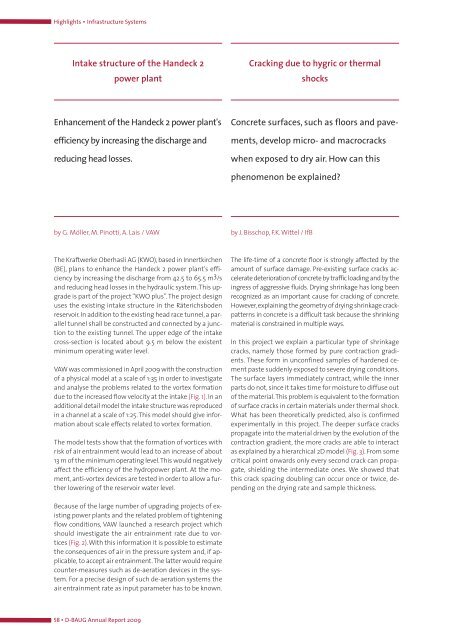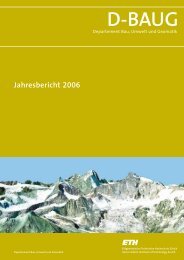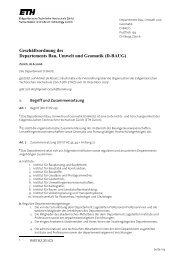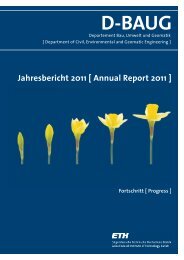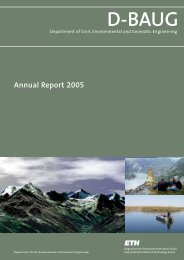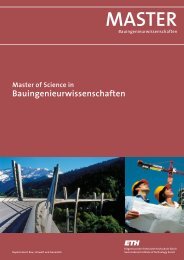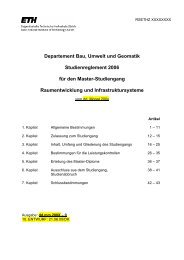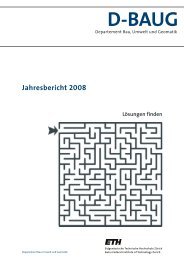D-BAUG - Departement Bau, Umwelt und Geomatik - ETH Zürich
D-BAUG - Departement Bau, Umwelt und Geomatik - ETH Zürich
D-BAUG - Departement Bau, Umwelt und Geomatik - ETH Zürich
Create successful ePaper yourself
Turn your PDF publications into a flip-book with our unique Google optimized e-Paper software.
Highlights ▪ Infrastructure Systems<br />
Intake structure of the Handeck 2<br />
power plant<br />
Enhancement of the Handeck 2 power plant's<br />
efficiency by increasing the discharge and<br />
reducing head losses.<br />
The Kraftwerke Oberhasli AG (KWO), based in Innertkirchen<br />
(BE), plans to enhance the Handeck 2 power plant's efficiency<br />
by increasing the discharge from 42.5 to 65.5 m 3 /s<br />
and reducing head losses in the hydraulic system.This upgrade<br />
is part of the project “KWO plus”.The project design<br />
uses the existing intake structure in the Räterichsboden<br />
reservoir. In addition to the existing head race tunnel, a parallel<br />
tunnel shall be constructed and connected by a junction<br />
to the existing tunnel. The upper edge of the intake<br />
cross-section is located about 9.5 m below the existent<br />
minimum operating water level.<br />
VAW was commissioned in April 2009 with the construction<br />
of a physical model at a scale of 1:35 in order to investigate<br />
and analyse the problems related to the vortex formation<br />
due to the increased flow velocity at the intake (Fig. 1). In an<br />
additional detail model the intake structure was reproduced<br />
in a channel at a scale of 1:25. This model should give information<br />
about scale effects related to vortex formation.<br />
The model tests show that the formation of vortices with<br />
risk of air entrainment would lead to an increase of about<br />
13 m of the minimum operating level.This would negatively<br />
affect the efficiency of the hydropower plant. At the moment,<br />
anti-vortex devices are tested in order to allow a further<br />
lowering of the reservoir water level.<br />
Because of the large number of upgrading projects of existing<br />
power plants and the related problem of tightening<br />
flow conditions, VAW launched a research project which<br />
should investigate the air entrainment rate due to vortices<br />
(Fig. 2).With this information it is possible to estimate<br />
the consequences of air in the pressure system and, if applicable,<br />
to accept air entrainment.The latter would require<br />
counter-measures such as de-aeration devices in the system.<br />
For a precise design of such de-aeration systems the<br />
air entrainment rate as input parameter has to be known.<br />
58 ▪ D-<strong>BAUG</strong> Annual Report 2009<br />
Cracking due to hygric or thermal<br />
shocks<br />
Concrete surfaces, such as floors and pave-<br />
ments, develop micro- and macrocracks<br />
when exposed to dry air. How can this<br />
phenomenon be explained?<br />
by G. Möller, M. Pinotti, A. Lais / VAW by J. Bisschop, F.K.Wittel / IfB<br />
The life-time of a concrete floor is strongly affected by the<br />
amount of surface damage. Pre-existing surface cracks accelerate<br />
deterioration of concrete by traffic loading and by the<br />
ingress of aggressive fluids. Drying shrinkage has long been<br />
recognized as an important cause for cracking of concrete.<br />
However,explaining the geometry of drying shrinkage crackpatterns<br />
in concrete is a difficult task because the shrinking<br />
material is constrained in multiple ways.<br />
In this project we explain a particular type of shrinkage<br />
cracks, namely those formed by pure contraction gradients.<br />
These form in unconfined samples of hardened cement<br />
paste suddenly exposed to severe drying conditions.<br />
The surface layers immediately contract, while the inner<br />
parts do not, since it takes time for moisture to diffuse out<br />
of the material.This problem is equivalent to the formation<br />
of surface cracks in certain materials <strong>und</strong>er thermal shock.<br />
What has been theoretically predicted, also is confirmed<br />
experimentally in this project. The deeper surface cracks<br />
propagate into the material driven by the evolution of the<br />
contraction gradient, the more cracks are able to interact<br />
as explained by a hierarchical 2D model (Fig. 3). From some<br />
critical point onwards only every second crack can propagate,<br />
shielding the intermediate ones. We showed that<br />
this crack spacing doubling can occur once or twice, depending<br />
on the drying rate and sample thickness.


